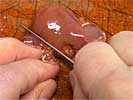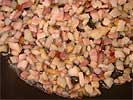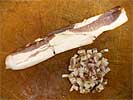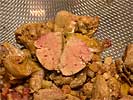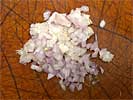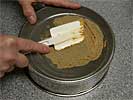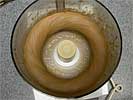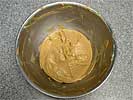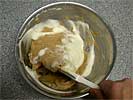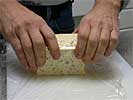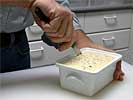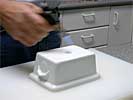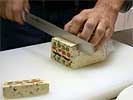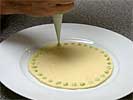
Terrine is one of those words that can have two meanings. It can mean a particular food preparation, or it can mean the physical dish, often made from earthenware, in which the preparation is prepared. Terrines are often rectangular, but they can also be oval or round. Confused?

Sometimes the terrine is removed from the terrine for slicing and serving, but sometimes the terrine is simply spooned out of the terrine. The contents of a terrine may be a
pâté, but
pâtés are not always made in a terrine. A modern chef may serve you a slice of something and call it a terrine, but never use a terrine at any time in its preparation. Still confused?
Terrines have been around for a long time, but recipes with “terrine” in the name seem to be less than a hundred years old. More confused?

Being confused about terrines is natural. And there’s probably nothing I can write that will make the subject any less confusing. I think of terrines as two separate concepts: a cold preparation put together in advance of serving or a type of container. The first concept may be prepared in the second, but that isn’t a firm requirement.
For this article, I have pulled together three very different recipes that are all called terrines and that are all prepared in terrines. The first two recipes are suitable as
entrées or first courses.
Terrine de foies de volaille is a terrine prepared primarily from chicken livers.
Terrine de légumes printaniers is a terrine that is assembled from a variety of vegetables.
Terrine de fruits en gelée consists of poached fruit suspended in wine-flavored gelatin and is suitable as a light dessert course.

The three recipes contained in this article are all designed for a 450-gram terrine. The size is a function of the amount of material that will fit in the dish, for example 450 grams of
pâté. This is approximately equivalent to 450 milliliters of water. You can determine how much water will fit in the terrine you are using and then accordingly adjust the recipe. Since none of the recipes are served in the terrine, they can all be prepared in a different rectangular container, such as a loaf pan. But only the
terrine de foies de volaille can be prepared in a non-rectangular terrine.
Terrines are great make-ahead dishes that always look like more work than they really require. For me, they are more play than work.
Michelin three-star chef Raymond Oliver (1909-1990) headed the kitchen at the Grand Véfour, one of Paris’s oldest restaurants in the post-war period. (The restaurant opened in 1784 as the trendy and chic Café de Chartres. In 1820, Jean Véfour took over as the new owner and renamed the restaurant after himself. The restaurant was closed in 1905 and reopened in 1947, when Oliver purchased it.) In 1953, he hosted France’s first cooking program on television and became a national celebrity.
Like many other great chefs, Oliver published a grand tome of recipes. His has been reprinted many times in multiple languages since it was originally published. It is from this book that the following recipe is adapted. Like others in the book, the recipe reflects classical French cooking as it was practiced after the second world war when ingredients were often in short supply. The recipe requires none of the exotic ingredients normally associated with three-star cooking.
terrine de foies de volaille
150 grams
fatty bacon, 5-mm dice
1 tablespoon
minced shallots
1 large sprig
fresh thyme
fine salt and freshly ground black pepper
100 milliliters
Port wine
2
egg whites, at room temperature
4.
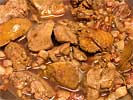
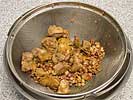
Drain the contents of the frying pan reserving the livers, shallots, and bacon in a bowl. Marinate with the wine for about an hour.
7.
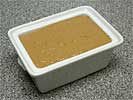
Pack the mixture into a 300-gram ceramic terrine. Cover and refrigerate until firm.
Yield: one 450-gram terrine, about 6 servings.
Ref: Raymond Oliver, La Cuisine, 1972, page 238.
Gelatin-based deserts may seem like a modern invention. After all, reliable home refrigeration was not common until the middle of the twentieth century and gelatin needs to be cooled to solidify it. But French cooks have been extracting and clarifying their own gelatin from veal hoofs for centuries. In 1867, Jules Gouffé published 13 recipes for gelées, or jellies as they were translated in the English-language edition a couple of years later, accompanied by a method for preparing the calf’s foot gelatin.
When adapting the following recipe from one taught at the cooking school in Amondans, France, I referred to Gouffé’s century-old recipes for additional guidance. Although this desert could be prepared in just about any shaped mold, the rectangular shape of a terrine produces an end product that is easy to serve and very attractive.
terrine de fruits en gelée, coulis de framboises
200 grams
granulated sugar
1 medium
firm pear, halved, peeled, cored
1 medium
apple, halved, peeled, cored
75 milliliters
Riesling wine
2 tablespoons
Riesling wine
1.
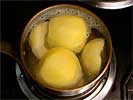
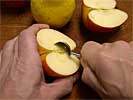
Combine the water and sugar in a saucepan. Add the apple and pear and place over high heat. Bring to a boil, reduce heat, cover, and simmer the fruit until barely tender. Do not over cook. The fruit is cooked when the tip of a small knife can easily be inserted into it. The pear generally cooks faster than the apple, but the cooking time is also a function of ripeness.
2.
When cooked, drain the fruit and arrange, cut side down, on a plate. Place the fruit in a refrigerator until chilled. Reserve the poaching liquid and chill. Chill the terrine.
3.
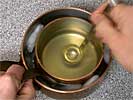
When the poaching liquid is cool, strain it through a piece of muslin. Combine 225 milliliters of the poaching liquid with the wine in a small saucepan. Place the gelatin in a glass of water for a few minutes to soften it. Squeeze out the water and add the gelatin to the saucepan. Place the saucepan over high heat and stir continuously until the gelatin is dissolved. Immediately remove the saucepan from the heat and cool the contents to room temperature in an ice bath.
4.
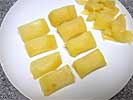
Cut each piece of fruit in half, lengthwise. Trim the fruit quarters to a uniform length, width, and height that allows them to stack neatly in the terrine with a bit of space on the sides.
5.
Keep the fruit and terrine as chilled as possible while working with it to decrease the time required for the gelatin to solidify and speed up the assembly process. Remove the terrine from the refrigerator and ladle some of the poaching liquid and gelatin combination into the bottom to a depth of about half a centimeter. Return the terrine to the refrigerator until the liquid solidifies.
6.
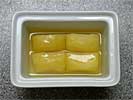
Arrange the apple quarters in the terrine so there is space on the sides and the ends. They should be touching where the two ends butt up. Ladle enough liquid into the terrine to come up the sides of the apple about halfway—they should not float. Place the terrine in the refrigerator until the liquid solidifies.
7.
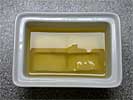
Ladle more liquid into the terrine until the apples are covered by a couple of millimeters of liquid. Return the terrine to the refrigerator until the liquid solidifies.
8.
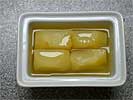
Arrange the pear quarters in the terrine so there is space on the sides and the ends. They should be touching where the two ends butt up. Ladle enough liquid into the terrine to come halfway up the sides of the pear. Place the terrine in the refrigerator until the liquid solidifies.
9.
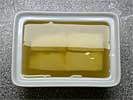
Ladle more liquid into the terrine until it is level with the top. Return the terrine to the refrigerator until the gelatin is very solid and the terrine is chilled thoroughly, about 6 hours or overnight.
10.
While the terrine is chilling, prepare the coulis. Place the raspberries, sugar, and wine in the bowl of a food processor and process until quite smooth. Force the puree through a medium-fine strainer. If there are any seeds remaining in the puree, force it a second time though a fine strainer. Chill the coulis until needed.
11.
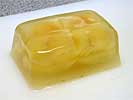
Unmold the terrine onto a flat surface that will fit into the refrigerator, such as a small plastic cutting board. Return the board to the refrigerator until it is time to cut the terrine.
12.
To plate the terrine, spoon a circle of raspberry coulis on each of the serving plates, which should have previously been chilled. If desired, decorate the coulis.
13.
Cut a thin slice, just enough to expose the fruit, from each end of the terrine and discard. Slice the terrine into thick slices. Place a slice on each plate.
Yield: one 450-gram terrine, about 4 servings.
Ref: L’École de Château d’Amondans, 10 June 1992.
If there is one dish that could be called a common denominator for the multiple times I worked, during a five-year period starting in 2000, in the kitchens of the Château d’Amondans, it is the following. Although presented under a number of aliases, the most common being Le Mosaïque, many of the banquet menus started with some variation of this terrine. No matter which variation was prepared, it was always a hit. As a plus for the kitchen staff, it was easy to prepare in the restaurant’s large, 50-portion, ceramic terrines.
The original recipe, as Chef Michel Chabran presented to the kitchen when it was still a cooking school and not a Michelin-starred restaurant, called for the terrine to be lined with blanched leek greens—something we never did when I was in the kitchen. Chabran also specified mincing the common mushrooms in a food processor with the cream—we always cut the mushrooms by hand into a fine dice, which is much more labor intensive.
One addition that I often observed was the placement of a slice of partially cooked (mi-cuit) foie gras in the center of the terrine. It was also common to use white asparagus in addition to the green called for in the recipe.
terrine de légumes printaniers
150 grams
common mushrooms, 3-mm dice
2 tablespoons
Nouilly Prat, or other dry white vermouth
300 milliliters
heavy cream
8 leaves (about 12 grams)
gelatin
fine salt and freshly ground white pepper
4 medium stalks
green asparagus
6 grams
dried morel mushrooms, hydrated
1 tablespoon
minced shallots
150 grams
cauliflower florets, cut into 3-cm pieces
125 milliliters
heavy cream
a few drops
Tabasco sauce
a handful
flat-leaf parsley
60 milliliters
heavy cream
1.
Chill the terrine in the refrigerator until needed.
2.
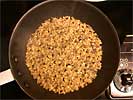

Heat 2 tablespoons of butter in a small frying pan over medium heat. Add the diced mushrooms. Sprinkle the mushrooms lightly with a little fine salt to draw out some of the mushroom’s water. Cook the mushrooms, stirring occasionally until the mushrooms are tender.
3.
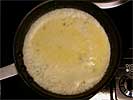
Add the Nouilly Prat and ignite the wine. Continue cooking until the wine is all evaporated. Add the cream and bring to a boil. When boiling remove from the heat.
4.
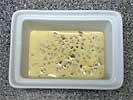
In the meantime, separate the leaves of gelatin and place them in a glass of cold water to soften. When soft, drain the gelatin, squeeze out the water, and add it to the hot mushroom cream mixture. Stir to dissolve the gelatin. Spoon a layer of the mixture into the bottom of the terrine. Return the terrine to the refrigerator. Set the frying pan aside to cool. Do not refrigerate.
5.
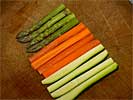
While the mushroom-cream mixture is being prepared, cut the vegetables to size. A single layer of each vegetable should fit in the terrine with about a half centimeter space between each piece and between the pieces and the sides of the terrine. No space is required at the ends. Trim the asparagus to length. Cut the zucchini lengthwise into quarters. Trim the quarters to length and square them off so they fit the terrine. Trim the carrots to length and cut four “squarish” pieces from them.
6.
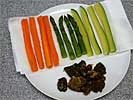

Bring a large saucepan of heavily salted water to a boil. Cook the asparagus, zucchini, and carrots until tender. Shock in an ice bath. Drain well and set aside in a refrigerator.
7.

Thoroughly drain the morel mushrooms. Trim the feet from the mushrooms and slit the side of each cap so they can open flat. Heat ½ tablespoon butter in a small frying pan over medium heat. Sweat the shallots until tender. Add the mushrooms and a splash of water. Quickly cook the mushrooms until they start to soften. Set aside in the refrigerator to cool.
8.
Remove the terrine from the refrigerator. Arrange the asparagus on a single layer in the bottom of the terrine. Leave space between the asparagus and the sides of the terrine and between each of the spears. Carefully ladle enough of the mushroom-cream mixture over the asparagus to barely cover them. Return the terrine to the refrigerator.
9.
When the asparagus layer has solidified, remove the terrine from the refrigerator. Arrange the carrots in a single layer in the terrine similar to the asparagus. Carefully ladle enough of the mushroom-cream mixture over the carrots to barely cover them. Return the terrine to the refrigerator.
10.

When the carrot layer has solidified, remove the terrine from the refrigerator. Arrange the morel mushrooms and shallots in a single layer. Cut the odd pieces to cover any open spots. Leave a centimeter border on the sides. Ladle enough of the mushroom-cream mixture over the mushrooms to cover them. Return the terrine to the refrigerator.
11.
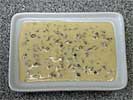
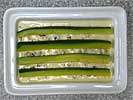
When the morel mushroom layer has solidified, remove the terrine from the refrigerator. Arrange the zucchini pieces in the terrine similarly to the other layers. Carefully ladle enough of the mushroom-cream mixture over the zucchini to barely cover them and fill the terrine. Return the terrine to the refrigerator.
12.
While the terrine contents are solidifying, prepare the sauce. Bring a large saucepan of heavily salted water to a boil. Add the cauliflower pieces and cook until quite tender, about 5 minutes.
13.
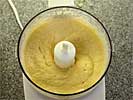
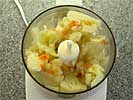
When cooked, drain the cauliflower well and place in the bowl of a small food processor along with the cream, lemon juice, and Tabasco sauce. Process until smooth. Season with fine salt and process briefly to mix.
14.
Strain the sauce and set aside in the refrigerator.
15.
To prepare the sauce decoration, bring a small saucepan of heavily salted water to a boil. Blanch the parsley until tender, about 3 minutes. Drain the parsley, cool in an ice bath, drain again and squeeze out as much water as possible. Add the parsley to the bowl of a small food processor along with the cream. Process until totally pureed. Set aside until needed.
17.
Place the parsley-cream in a cornet.
Yield: one 450-gram terrine, about 6 servings.
Ref: presented by Michel Chabran at l’École de Château d’Amondans, 19 April 1994.
©2005, 2014 Peter Hertzmann. All rights reserved.
 Terrine is one of those words that can have two meanings. It can mean a particular food preparation, or it can mean the physical dish, often made from earthenware, in which the preparation is prepared. Terrines are often rectangular, but they can also be oval or round. Confused?
Terrine is one of those words that can have two meanings. It can mean a particular food preparation, or it can mean the physical dish, often made from earthenware, in which the preparation is prepared. Terrines are often rectangular, but they can also be oval or round. Confused? Sometimes the terrine is removed from the terrine for slicing and serving, but sometimes the terrine is simply spooned out of the terrine. The contents of a terrine may be a pâté, but pâtés are not always made in a terrine. A modern chef may serve you a slice of something and call it a terrine, but never use a terrine at any time in its preparation. Still confused?
Sometimes the terrine is removed from the terrine for slicing and serving, but sometimes the terrine is simply spooned out of the terrine. The contents of a terrine may be a pâté, but pâtés are not always made in a terrine. A modern chef may serve you a slice of something and call it a terrine, but never use a terrine at any time in its preparation. Still confused? Being confused about terrines is natural. And there’s probably nothing I can write that will make the subject any less confusing. I think of terrines as two separate concepts: a cold preparation put together in advance of serving or a type of container. The first concept may be prepared in the second, but that isn’t a firm requirement.
Being confused about terrines is natural. And there’s probably nothing I can write that will make the subject any less confusing. I think of terrines as two separate concepts: a cold preparation put together in advance of serving or a type of container. The first concept may be prepared in the second, but that isn’t a firm requirement. The three recipes contained in this article are all designed for a 450-gram terrine. The size is a function of the amount of material that will fit in the dish, for example 450 grams of pâté. This is approximately equivalent to 450 milliliters of water. You can determine how much water will fit in the terrine you are using and then accordingly adjust the recipe. Since none of the recipes are served in the terrine, they can all be prepared in a different rectangular container, such as a loaf pan. But only the terrine de foies de volaille can be prepared in a non-rectangular terrine.
The three recipes contained in this article are all designed for a 450-gram terrine. The size is a function of the amount of material that will fit in the dish, for example 450 grams of pâté. This is approximately equivalent to 450 milliliters of water. You can determine how much water will fit in the terrine you are using and then accordingly adjust the recipe. Since none of the recipes are served in the terrine, they can all be prepared in a different rectangular container, such as a loaf pan. But only the terrine de foies de volaille can be prepared in a non-rectangular terrine.


